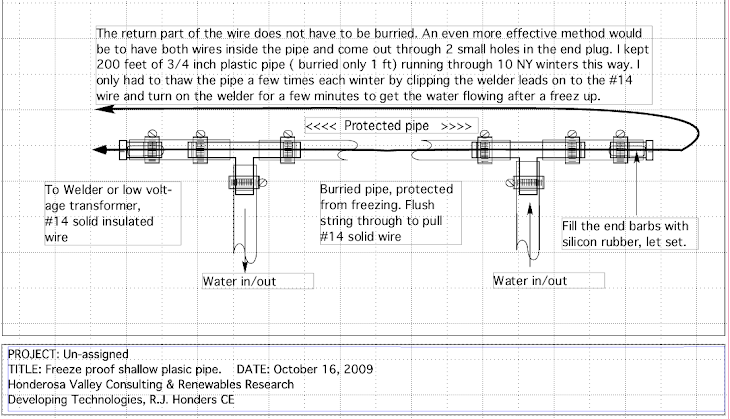Wednesday, June 25, 2008
Grid Connected Or Autonomous?
We have been up and running autonomously (off the grid) with 12KW capability. On average our little mini grid only draws 2 to 3KW so all the rest gets wasted in dump loads or as water over the dam. (It does make a pretty waterfall!) If we generated this electricity with solar panels or wind we would qualify for 'net metering' which requires very little in the way of special switching and essentially allows you to store energy in the grid, running your meter backward. When your generated energy drops due to darkness, no wind, or in our case no water in August & September, you would draw energy from the grid running your meter in the normal direction. In our case we would be sending the grid much more energy during the ten months that we have ample water than we would use in the couple of dry months. We would gain the frequency and voltage stability of the grid and we could do away with all the voltage / frequency controls, governors, dump loads and associated controllers, simplifying the system and maintenance. We have a transfer switch which will connect us to utility power if our hydro drops out, and back to hydro when that comes back up. But we can never connect both power sources together legally even though technically this is the best for all parties! The utility / grid would get the excess energy we generate in a year, and we would use the grid to store the energy we need for a couple of dry months and simplify controls while increasing stability. There is no safety issue using an induction generator directly connected to the grid (through a standard meter and disconnect) because this type of generator will stop producing current when it senses no excitation voltage from the grid. Thus if the grid goes down so will the induction generator. This may be disappointing if you were hoping to get through the next grid blackout with your own power, but then you could disconnect from the grid and switch in some excitation capacitors to run autonomously if you can muster more than a few thousand watts on your own.
Utility Company Meters
Utility company meters come in many flavors. I discovered that (shortly after getting our micro hydro running) that our meter measures 'absolute' power. This means that the meter does not care weather the power flows them to us or us to them. It just keeps increasing the meter reading (and our bill) even when we send power to the utility! This tactic is what keeps me from connecting to the grid and sending them (free) power, and paying for the privilege. We used to have an older spinning disk meter. This type would decrement the meter reading when power flowed to the utility and increment the reading when we drew power. This is the 'net metering' setup that would benefit all parties. The best they could do with those meters is put a ratchet on the spinning disk so it could only spin forward, incrementing the meter reading when drawing power, but it would just stand still when you sent power their way.
Sunday, June 1, 2008
Butterfly valve voltage controller
 Here are two views of the 4 inch butterfly valve and modified (a little) car window operator that modulates the valve to keep the voltage steady as power demand varies.
Here are two views of the 4 inch butterfly valve and modified (a little) car window operator that modulates the valve to keep the voltage steady as power demand varies.Frustration overcame when I tried to upload PDF files to my blog, so here is a link to the PDF diagram for the valve controller. The butterfly valve is driven by a car electric window operator becaus
 e of its high torque and harsh environment operating capability. The controller was built to operate 2 valves and has battery backup for manual control, when all else fails.
e of its high torque and harsh environment operating capability. The controller was built to operate 2 valves and has battery backup for manual control, when all else fails.http://www.scribd.com/doc/3198857/Valve-Voltage-Frequency-Control-Circuit
Download http://www.scribd.com/doc/3198677/3-phase-motor-as-1-phase-generator-diagram.pdf
Labels: Energy from Water
Butterfly valve,
control,
diagram,
microhydro,
voltage
Subscribe to:
Comments (Atom)








